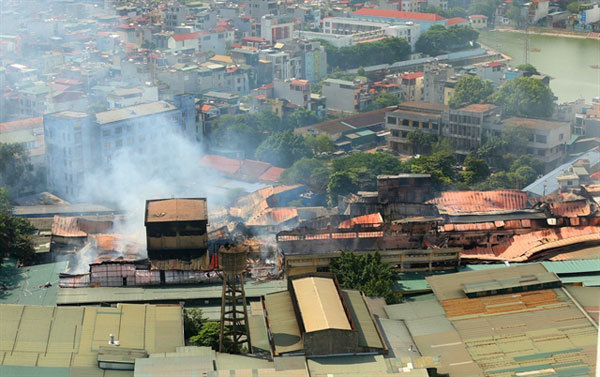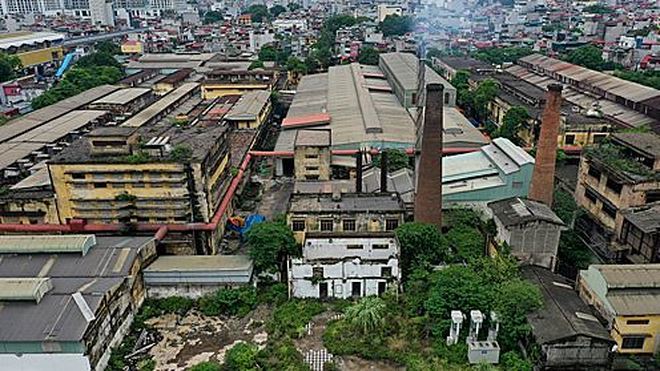 |
| A fire broke out at Rang Dong lightbulb factory on August 28 last year in Hanoi, releasing toxic air and mercury into the surrounding environment, resulting in a major scare for the entire city. — VNA/VNS Photo |
The results of a survey conducted by the People’s Participation Working Group (PPWP) revealed that 98.49 per cent of interviewees supported Hanoi’s decision to move polluting factories from residential areas.
The survey, run in May and June this year, interviewed 152 people residing in Hanoi to collect their opinions on public space and the relocation of factories.
Nearly 60 per cent of those surveyed said their living space was affected by the operation of factories, while 80.5 per cent said they were affected by toxic air pollution, said Le Quang Binh, president of PPWP
Some 92 per cent of interviewees said public space was important to their lifestyles and 79 per cent said public space in the city has failed to meet demand.
A field survey of PPWG at 39 factories that must be relocated in Hai Ba Trung and Thanh Xuan districts revealed only 21 had been relocated.
Under a plan approved in 2016, 117 facilities must be relocated from 12 inner districts by 2020, according to a report from Hanoi People’s Committee.
However, relocations are at a standstill due to problems securing capital for relocation and lack of favourable policies for using land in the most effective way.
A fire that broke out at a warehouse of Rang Dong Light Source and Vacumn Flash Joint Stock Company in Thanh Xuan District’s Ha Dinh Street on August 28 last year drew public attention to the issue.
A report that 27kg of mercury might have been leaked into the surrounding residential areas after the fire raised concern over contamination and forced many people living in its vicinity to move out of their homes.
The fire served as a wake-up call, prompting city authorities to fast-track the relocation of industrial manufacturers.
Nguyen Thi Hoa, 74, a resident from Ha Dinh Street, said locals have been suffering from serious pollution due to heavy smoke discharged from three industrial plants namely Sao Vang Rubber JSC, Thang Long Tobacco company and Rang Dong light bulb for many years.
“We have sent complaints to relevant agencies many times but nothing has been improved,” he told Việt Nam News.
Greenspace
The survey by PPWG pointed out that most surveyed people want factories which pose risks to the environment to be replaced by parks or flower gardens (93 per cent) while many of them want to use the land for building health and education facilities.
According to Dinh Dang Hai, an expert from HealthBridge Foundation of Canada in Vietnam, public space in Hanoi is very limited.
Overall public space per person in Hanoi is only 3 square metres and as low as 30 square centimetres in Hoan Kiem District.
“There is a big gap for Hanoi to meet the standard of public space [5 square metres per person] compared to other cities in the world,” he said.
Pham Thuy Loan, deputy director of Vietnam National Institute of Architecture, agreed, saying urban design was a field which mainly focused on the quality of urban space for people. Therefore, public space must be easily accessible.
She suggested the city should take advantage of existing parks and green trees to increase green space.
It was essential to change the purpose of unused land, especially after factories relocation, she said, adding that priority should be given to the development of green trees and public space to improve the people’s living condition, Loan said. VNS

Hanoi's polluting factories reluctant to give up land to authorities
Authorities in the capital had planned to move 117 polluting facilities out of the inner city to make space for public schools, parking lots and public spaces.

Polluted factories stay in inner city for years
On April 22, 2003, the Government issued a decision approving the plan to thoroughly handle the facilities causing serious environmental pollution.
 The relocation of factories posing risks of pollution from residential areas was necessary and more public space should be created, heard participants at a seminar held in Hanoi on Thursday." itemprop="description" />
The relocation of factories posing risks of pollution from residential areas was necessary and more public space should be created, heard participants at a seminar held in Hanoi on Thursday." itemprop="description" />